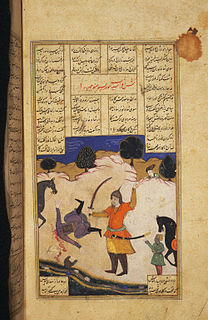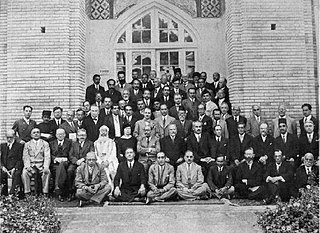Related Research Articles

Abul-Qâsem Ferdowsi Tusi, also Firdawsi, or just Ferdowsi was a Persian poet and the author of Shahnameh, which is one of the world's longest epic poems created by a single poet, and the greatest epic of Persian speaking countries. Ferdowsi is celebrated as one of the most influential figures of Persian literature and one of the greatest in the history of literature.

The Shahnameh or Shahnama is a long epic poem written by the Persian poet Ferdowsi for Sultan Mahmud of Ghazni between c. 977 and 1010 CE and is the national epic of Greater Iran. Consisting of some 50,000 "distichs" or couplets, the Shahnameh is one of the world's longest epic poems. It tells mainly the mythical and to some extent the historical past of the Persian Empire from the creation of the world until the Muslim conquest in the seventh century. Iran, Azerbaijan, Afghanistan, Tajikistan and the greater region influenced by Persian culture such as Armenia, Dagestan, Georgia, Turkey, Turkmenistan and Uzbekistan celebrate this national epic.

A Persianate society is a society that is based on or strongly influenced by the Persian language, culture, literature, art and/or identity.
Abu Mansur Daqiqi, better simply known as Daqiqi (دقیقی), was one of the most prominent Persian poets of the Samanid era. He was the first to undertake the creation of the national epic of Iran, the Shahnameh, but came to an abrupt end in 977 after only completing 1,000 verses. His work was continued by his contemporary Ferdowsi, who would later become celebrated as the most influential figure in Persian literature.

Sohrāb or Suhrāb is a legendary warrior from the Shahnameh, or the Tales of Kings by Ferdowsi in the tragedy of Rostam and Sohrab. He was the son of Rostam, who was an Iranian warrior, and Tahmineh, the daughter of the king of Samangam, a neighboring country. He was slain at a young age by his father Rostam. Rostam only found out he was his son after fatally wounding him in a duel. Kaykavous, the king of Iran, delayed giving Rostam the panacea to save Sohrab as he feared losing his power to the alliance of the father and the son. Rostam gave Tahmineh a bracelet as a reminder and a sign to his son.
Shahrokh Maskoub, was an Iranian writer, translator, scholar and university professor.

Nowzar is the ninth Shah of the Pishdadian dynasty of Persia according to Shahnameh. He is the son of Manuchehr and becomes the Shah of Iran after his father's death. His reign of seven years comes to an end when he is killed by Afrasiab during a battle.
Persian theater goes back to antiquity. The first initiation of theater and phenomena of acting can be traced in ceremonial theaters to glorify national heroes and legends and to humiliate the enemy, as in the classics "Soug Sivash" and "Mogh Koshi" (Megakhouni). Ancient Persian theatre and dance was significantly researched by the Greek historian Herodotus of Halikarnassos, who lived during the Persian rule in Greece. In his work Book IX (Calliope), he describes the history of Asian empires and also the Persian wars until 478 BC.

Jalal Matini is a scholar of Persian literature, particularly renowned for his expertise on the epic Shahnameh by Ferdowsi, and contemporary Iranian studies. He is also known for producing the critical edition of the Kush Nama.
Kashvād is an Iranian mythical hero. He is an emblem of victory, justice and loyalty in a story narrated in the poetic opus of Shahnameh, the national epic of Iran by the 10th-century poet Ferdowsi Tousi.
The thousand-year celebration of Ferdowsi's birthday was held in Berlin on 27 September 1934 under the administration of the German Ministry of Science, Education and Culture (Reichserziehungsministerium), on the occasion of millenary celebration of Ferdowsi, announced by the government of Iran at the beginning of that year. The Berlin ceremony was held in the German Archaeological Institute. The Zeitschrift der Deutschen Morgenländischen Gesellschaft published a report of these ceremonies in its 1934 edition.

The Ferdowsi millennial celebration was a series of celebrations and scholarly events in the year 1934 to commemorate the thousandth anniversary of Ferdowsi's birth. The Ferdowsi millennial was held at the initiative of Reza Shah Pahlavi and was announced at the beginning of the year by the government of Iran. The Millennial Congress convened for five days, from 2 to 6 October 1934, in Tehran, and more than eighty notable European and Iranian scholars attended the congress. The celebrations lasted for nearly a month.

Piranshahr is a city located in West Azerbaijan Province in west Iran. It is the capital of Piranshahr County.

The Tomb of Ferdowsi is a tomb complex composed of a white marble base, and a decorative edifice erected in honor of the Persian poet Ferdowsi located in Tus, Iran, in Razavi Khorasan province. It was built in the early 1930s, under the Reza Shah, and uses mainly elements of Achaemenid architecture to demonstrate Iran's rich culture and history. The construction of the mausoleum as well as its aesthetic design is a reflection of the cultural, and geo-political status of Iran at the time.

Faramarz is an Iranian legendary hero (pahlavan) in Ferdowsi's Shahnameh. He was son of Rostam and at last killed by Kay Bahman.

Hāmāvarān is a place in Shahnameh and other Iranian writings. The consensus between scholars is that Hamavaran is usually identified with Yemen. According to Abdolhossein Zarrinkoob, it is an altered form of Himyarite Kingdom.
House of Goudarz or Goudarzian (گودرزیان) is an important Iranian family in Shahnameh and Persian mythology. They are descendants of Kave the Blacksmith. Gooderzian is also sometimes known as free man, meaning he does not want to be defeated or captured.
House of Viseh is the most important Turanian clan in Shahnameh and Persian mythology. They are descendants of Tur. Tur is father of Zadashm and grandfather of Viseh. Viseh is the leading member of this clan. Viseh first war with Qaren is in the Iran-Turan war, both of which are not alive in Shahnameh afterwards.
House of Nowzar also known as Nowzarian (نوذریان) is an important Iranian clan in Shahnameh and Persian mythology. Nowzar ruled Iran for seven years. After his death, the grandees of Iran didn't recognize his sons Tous and Gostaham as the shahanshah of Iran and instead they gave the throne to Kayanian dynasty.

Behrouz Servatian (1937–2012), was an Iranian literary scholar, professor, and authority on the great Iranian lyric poet, Nizami Ganjavi.
References
- ↑ "Spotlight Detail". UCI Samuel Jordan Center for Persian Studies and Culture.
- ↑ Reynolds, Dwight F. (1997). "A Review of One's Own: A Response to Omidsalar". Western Folklore. 56 (1): 79–83. doi:10.2307/1500387. ISSN 0043-373X.
- ↑ Lewis, Franklin (4 May 2015). "The Shahnameh of Ferdowsi as World Literature". Iranian Studies. 48 (3): 313–336. doi:10.1080/00210862.2015.1023063. ISSN 0021-0862.
- ↑ "Iranian academics ask Western scholars avoid considering Ferdowsi's poetry medieval | IBNA". Iran's Book News Agency (IBNA). 16 January 2021.